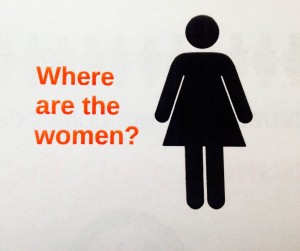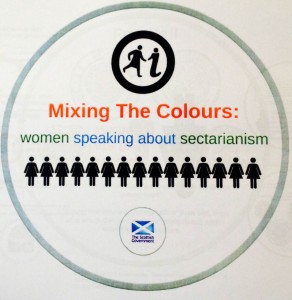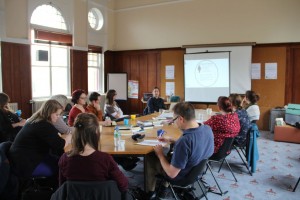On Tuesday 27th May, the ‘Mixing the Colours: Women Speaking About Sectarianism’ project was delighted to welcome a number of our partner organisations to Glasgow Women’s Library for a workshop on ‘Women and Sectarianism’, led by Mixing the Colours Development Worker, Rachel Thain-Gray. The workshop gave an overview of the ‘location’ of women within the dialogue on sectarianism, and how those of us who are engaged in sectarianism awareness projects research, understand and tackle the topic in relation to women’s perspectives.
Mixing the Colours research into women’s perceptions of intra-Christian sectarianism in Scotland has found that the majority of inquiry on the subject has focused on the examination of football-related criminal sectarian behaviour amongst young men. This has often led to an excessively limited study of sectarianism, a stereotype, where women tend to be considered peripherally and ‘conventionally’; usually as the victims of domestic abuse.
During Tuesday’s session, Rachel made reference to Goodall, K. and Malloch, M. (2013) ‘Women, Football and Communities: Gendered Conceptualisations of ‘Sectarianism’’ in Flint J, Kelly J (ed.). Bigotry, Football and Scotland: Perspectives and Debates pp. 163-179, which has cast some much-needed light on women’s experiences and understanding of sectarian behaviour, pointing out the importance of incorporating a broader appreciation of the opinions of women (who make up 51% of the Scottish population) into our research on sectarianism and how we tackle it.
 We looked at the ways in which women feel they must engage in avoidance tactics – staying home or avoiding particular areas during certain events – in order to preserve their own safety and to protect themselves from sectarian language or behaviour. This is particularly illustrative of one of the central observations of the work undertaken by Mixing the Colours so far – that the experiences of many women are often ‘hidden’, and that gender-based violence and physical and verbal abuse occur in environments which may or may not be private or domestic. Domestic or public, these experiences are very often of a ‘concealed’ nature either way, impacting women by means of forcing often personally disruptive and inconvenient circumvention of specific individuals, or withdrawal of participation in areas or events out of fear for personal security and the desire to avoid gender-specific abuse. It is this kind of covert, gender-specific, unseen experience which often makes women’s views so much easier to ignore, and to omit from the more visible discourse about the problem of sectarianism and how it can and ought to be handled.
We looked at the ways in which women feel they must engage in avoidance tactics – staying home or avoiding particular areas during certain events – in order to preserve their own safety and to protect themselves from sectarian language or behaviour. This is particularly illustrative of one of the central observations of the work undertaken by Mixing the Colours so far – that the experiences of many women are often ‘hidden’, and that gender-based violence and physical and verbal abuse occur in environments which may or may not be private or domestic. Domestic or public, these experiences are very often of a ‘concealed’ nature either way, impacting women by means of forcing often personally disruptive and inconvenient circumvention of specific individuals, or withdrawal of participation in areas or events out of fear for personal security and the desire to avoid gender-specific abuse. It is this kind of covert, gender-specific, unseen experience which often makes women’s views so much easier to ignore, and to omit from the more visible discourse about the problem of sectarianism and how it can and ought to be handled.
At Glasgow Women’s Library, the focus is on the lessons that women can learn from each other and what we can teach one another based on our own experiences. This informal approach to communicating our ideas of tolerance (and intolerance) has led to a closer understanding of how sectarianism can co-occur with racism, homophobia, misogyny, anti-immigration and transphobia to form an ‘intersectional bigotry’. Feedback from workshop and discussion participants indicates that women can and do experience intersectional bigotry across the full ambit of situations and environments in which they are engaged – sometimes, but not always, in the home.
The Library has always set out to be a catalyst for change which is driven by all women, and Mixing the Colours has kept this ethos at the very centre of its work, by providing safe spaces and new ways for women to communicate their own oral histories and to conduct their own action research with their own voices, rather than being the subjects of (mis)representation. It is clear that women’s experiences of sectarianism form part of the wider issue of a persistent exclusion of women from certain groups and environments, and that this exclusion contributes to a sense of women’s attitudes as being indistinct from those of men, or less valid to the wider discussion.
Mixing the Colours has adopted a creative approach to understanding and tackling sectarianism, with creative writing and photography workshops, film and discussion as core activities designed to allow women to speak for themselves – rather than being spoken for – on the issue. The project has hosted women on Glasgow Women’s Library premises, and has gone out to meet women in Lockerbie, Aberdeen, Sutherland and beyond. We have reached out to BME women, women of all ages, disabled individuals and LGBT groups, too. The project has also engaged in partnership working with organisations including the Scottish Book Trust, LGBT Youth Scotland and the University of Stirling, looking at how issues such as education, religion and culture impact on how women see and respond to sectarian language and behaviour. One of the aims of the project is to find out how ready and able women really feel to challenge sectarianism where they find it. Participants have indicated that Mixing the Colours workshops and events have provided them with fresh and innovative ways of ‘taking a stand’, through an increase in confidence, political awareness and personal research as well as their creative output.
As Mixing the Colours moves forward, we will continue to reach out to more women on both a group and individual basis, through further workshops and discussions. Women who have contributed creative writing to the project are in the process of being interviewed and recorded, and a publication of creative writing will also be made available as part of the celebration of the project culminating in a conference at Glasgow Women’s Library in March 2015. In addition, Mixing the Colours seeks to compile, and contribute to, a bibliography of resources on sectarianism, which bring the role of women in education, the community, the media, the workplace and the home to the centre of the dialogue on the topic.
We would like to extend our thanks to everyone who came along to the session on Tuesday 27th May for their contribution to the discussion. Mixing the Colours is always keen to welcome new interviewees, contributors and volunteers. You can find out about the project, and access a current list of resources including books, articles and film, at https://womenslibrary.org.uk/inspiring-resources/mixing-the-colours/



Comments are closed.